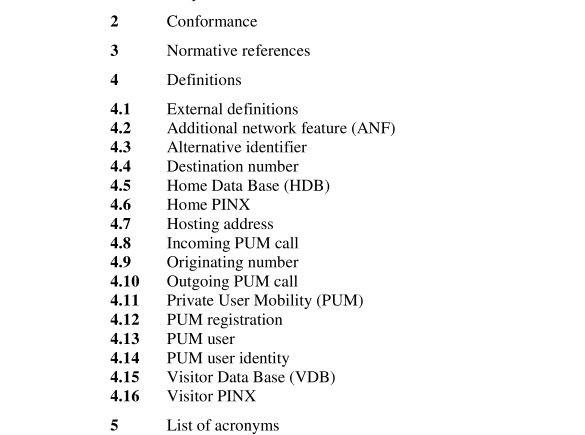ISO IEC 17877:2000 pdf download – Information technology — Telecommunications and information exchange between systems — Private Integrated Services Network — Specification, functional model and information flows — Private User Mobility (PUM) — Call handling additional network features.
1 Scope This International Standard specifies the Additional Network Features (ANF) Private User Mobility Incoming Call (PUMI) and Private User Mobility Outgoing Call (PUMO), which are applicable to various basic services supported by Private Integrated Services Networks (PISN). Basic services are specified in ISO/IEC 11574. ANF-PUMI is an additional network feature that directs incoming calls to a PUM user within a PISN regardless of the PUM user’s geographical location within the PISN, provided the PUM user’s location is known. ANF-PUMO is an additional network feature that permits the PISN to process call requests from a PUM user at the home location, ifrequired. Additional network feature specifications are produced in three stages, according to the method described in ETS 300 387. This International Standard contains the stage 1 and stage 2 specifications of ANF-PUMI and ANF-PUMO. The stage 1 specification (clauses 6 and 7) specifies the general feature principles and capabilities. The stage 2 specification (clauses 8 and 9) identifies the Functional Entities involved in the additional network features and the information flows between them. 2 Conformance In order to conform to this International Standard, a stage 3 standard shall specify signalling protocols and equipment behaviour that are capable of being used in a PISN which supports the additional network features specified in this International Standard. This means that, to claim conformance, a stage 3 standard is required to be adequate for the support of those aspects of clauses 6 and 7 (stage 1) and clauses 8 and 9 (stage 2) which are relevant to the interface or equipment to which the stage 3 standard applies. 3 Normative references The following standards contain provisions which, through reference in this text, constitute provisions of this International Standard. At the time of publication, the editions indicated were valid. All standards are subject to revision, and parties to agreements based on this International Standard are encouraged to investigate the possibility of applying the most recent editions of the standards indicated below. Members of IEC and ISO maintain registers of currently valid International Standards. ISO/IEC 11571:1998, Information technology — Telecommunications and information exchange between systems — Private Integrated Services Network — Addressing. ISO/IEC 11574:1994, Information technology — Telecommunications and information exchange between systems — Private Integrated Services Network — Circuit-mode 64 kbit/s bearer services — Service description, functional capabilities and information flows. ISO/IEC 11579-1:1994, Information technology — Telecommunications and information exchange between systems — Private Integrated Services Network — Part 1: Reference configuration for PISNexchanges (PINX). ISO/IEC 13872:1995, Information technology — Telecommunications and information exchange between systems — Private Integrated Services Network — Specification, functional model and information flows — Call diversion supplementary services. ISO/IEC 15428:1999, Information technology — Telecommunications and information exchange between systems — Private Integrated Services Network — Specification, functional model and information flows — Wireless Terminal Location Registration supplementary service and Wireless Terminal Information Exchange additional network feature.
ISO IEC 17877:2000 pdf download – Information technology — Telecommunications and information exchange between systems — Private Integrated Services Network — Specification, functional model and information flows — Private User Mobility (PUM) — Call handling additional network features






